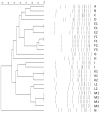Risk factors for healthcare-associated extensively drug-resistant Acinetobacter baumannii infections: a case-control study
- PMID: 24465819
- PMCID: PMC3897568
- DOI: 10.1371/journal.pone.0085973
Risk factors for healthcare-associated extensively drug-resistant Acinetobacter baumannii infections: a case-control study
Abstract
The emergence of extensively drug-resistant Acinetobacter baumannii (XDRAB) is a serious threat to hospitalized patients. From 2008 to 2010, surveillance detected 25 hospital-acquired infection (HAI) cases caused by XDRAB at a medical center in Taipei. The site of XDRAB infection was bloodstream (n = 8), urinary tract (n = 12), lower respiratory tract (n = 3), surgical site (n = 1), and cardiovascular (n = 1). The isolates were resistant to all currently available antibiotics except for colistin. The XDRAB isolates are genetically diverse, shown by pulsed-field gel electrophoresis, but 23 of 25 harbored class 1 integron with a 2.3-kb gene cassette. Most of these isolates carry OXA-23 (n = 21) and OXA-51-like carbapenemase genes (n = 25). To identify the risk factors, a case-control study was conducted. The 25 cases were compared with 100 controls randomly selected from hospitalized patients without XDRAB-HAIs, matched by the onset date, ward, and age, at a ratio of 1∶4. Prior use of imipenem, meropenem, piperacillin/tazobactam or fourth-generation cephalosporins (adjusted OR: 3.2, 95% CI: 1.03-10.2, P = 0.04) and >30 days bed-ridden (adjusted OR: 6.0, 95% CI: 1.3-27.6, P = 0.02) were found to be the independent risk factors for XDRAB-HAIs. These findings highlight that, even in the absence of clonal dissemination, XDRAB can emerge under the selective pressure of broad-spectrum antibiotics and causes subsequent HAIs in compromised hosts. An appropriate response to the XDRAB threat therefore should include a component of prudent use of broad-spectrum antibiotics active against gram-negative bacteria.
Conflict of interest statement
Figures
References
-
- Peleg AY, Bell JM, Hofmeyr A, Wiese P (2006) Inter-country transfer of Gram-negative organisms carrying the VIM-4 and OXA-58 carbapenem-hydrolysing enzymes. J Antimicrob Chemother 57: 794–795. - PubMed
-
- Carvalho KR, Carvalho-Assef AP, Peirano G, Santos LC, Pereira MJ, et al. (2009) Dissemination of multidrug-resistant Acinetobacter baumannii genotypes carrying bla(OXA-23) collected from hospitals in Rio de Janeiro, Brazil. Int J Antimicrob Agents 34: 25–28. - PubMed
-
- Gur D, Korten V, Unal S, Deshpande LM, Castanheira M (2008) Increasing carbapenem resistance due to the clonal dissemination of oxacillinase (OXA-23 and OXA-58)-producing Acinetobacter baumannii: report from the Turkish SENTRY Program sites. J Med Microbiol 57: 1529–1532. - PubMed
-
- Kuo HY, Yang CM, Lin MF, Cheng WL, Tien N, et al. (2010) Distribution of blaOXA-carrying imipenem-resistant Acinetobacter spp. in 3 hospitals in Taiwan. Diagn Microbiol Infect Dis 66: 195–199. - PubMed
Publication types
MeSH terms
Substances
LinkOut - more resources
Full Text Sources
Other Literature Sources


